MENU


We’ve previously discussed your Replacement Window Frame Material, your Window Glass and the many aspects of the actual Window Installation that need to be addressed. The final pillar supporting your replacement window project success is the Design of the window you select to replace the existing windows in your home.
The window design, or how it looks, is likely one of the first things you evaluate in selecting the windows to go in your home. In this article, we’ll discuss your window’s design from the perspective of its appearance, features, options and functionality.
There are a number of questions you should ask yourself or your window sales professional when considering the selection your new replacement windows. A few of those questions will include:
Make sure the company you choose will have a selection of windows to match the architectural style of your home.
Be sure to compare different window manufacturers’ windows side by side and be sure to note:
Renewal by Andersen’s Window Visualizer Tool lets you see how your windows will look on you specific home.
You probably spent a lot of time picking out the colors for the walls, furnishings, window treatments and such for your home. Be sure to ask the same of your replacement window choice.
You want your windows to blend with your home’s style and look like a natural part of the design and not some afterthought. The only way to do this is to be able to match the color of your window to the color of your home and its particular style.
Your windows don’t have to look the same inside and out. Your windows should match both the inside of your home as well as the outside. Be sure to consider:
The only way to get the real look of real wood that can be stained or painted to match the trim in the rest of your house is to have a real wood interior. Let’s face it, no matter how good a job the faux finish is, it’s still fake; you’ll know it and visitors to your home will likely pick it up at a glance.
Our last post discussed Replacement Window Frame thickness and color selection. In this second part of our four-part series on the Window Design Pillar of your replacement window satisfaction, we’ll discuss your Window Hardware color, style and ease of operation options.
As much as the window glass and frame, your replacement window hardware will affect your long-term satisfaction with your windows. Hardware is most noticeable from the inside of the home, so every time you look out your windows you’ll see your hardware. If it matches and blends with your décor, it’ll seem like a seamless part of your furnishings, but if it doesn’t, it’ll be an eyesore that bothers you day-in and day-out.
Appearance is one thing, but functionality is another. Difficulties operating your windows can be a sore spot that can ruin your happiness nearly every day for years. If your windows aren’t comfortable to open and close, you’ll be discouraged from opening them to let in the fresh air as often as you might otherwise. If they’re “a pain” to open and close, how motivated will you be to clean your windows. In the worst case, bad hardware can simply be a safety and security risk to you and your family.
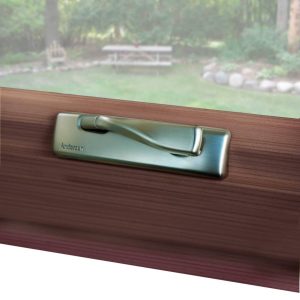 Consider the choices and selection available on the replacement windows you’re considering. Do they come in different styles, colors and finishes to match your home’s décor? Some windows only have hardware in one color even if their frames are offered in multiple colors. A while lock on a tan window frame is not going to look like it’s an integral part of the window, will it? When they do have more than one color available, is the hardware only available in colors to match the window frame (white on white; brown on brown? Or are there other hardware choices that can match the other hardware in your home (brass, nickel, etc.)? Consider the room where your windows will be installed. You might seriously consider one type of hardware for your kitchen and a completely different style for a bedroom. Make sure your window manufacturer will enable you to make those choices.
Consider the choices and selection available on the replacement windows you’re considering. Do they come in different styles, colors and finishes to match your home’s décor? Some windows only have hardware in one color even if their frames are offered in multiple colors. A while lock on a tan window frame is not going to look like it’s an integral part of the window, will it? When they do have more than one color available, is the hardware only available in colors to match the window frame (white on white; brown on brown? Or are there other hardware choices that can match the other hardware in your home (brass, nickel, etc.)? Consider the room where your windows will be installed. You might seriously consider one type of hardware for your kitchen and a completely different style for a bedroom. Make sure your window manufacturer will enable you to make those choices.
It’s important to operate any window you are considering before making your selection. How easy is it to open and close? How does the hardware feel? Is it smooth and comfortable or do you feel rough edges on the casting? Does it feel strong and durable, like it will last for years or flimsy and weak, like you might break it if you strain it? How easy are the windows to open and close? Do they slide up or down or side to side easily? Do they crank out smoothly? Do they close with a satisfying, secure feel? Does the hardware slide into place easily or did you have to “fiddle” with them. Remember, the windows you see in the showroom should be the best windows the company has to offer. No business is likely to put a poor performing window on the sales floor, so if you notice the slightest issue, you should consider what issues you might experience over time on the windows installed in your home. Consider that windows that do not open, close and lock securely can become a security risk for your family. Windows are one of the most common places of entry for intruders. If your windows aren’t easy to close and lock securely, will that become a security risk for your family?
After considering the operation and security of the window, consider other potential hazards or nuisances they may present. Does the hardware stick out from the window? Could that become a safety hazard for small children running past the window? Might it get in the way of your window treatments? Think about how you will be use and decorate your windows. Is the hardware going to make that easy or difficult?
In the first two posts in this, the third of four parts in our Four Pillars of a Great Replacement Window experience, we covered window styles, frame thickness and color. In this post, we’ll discuss the importance of and design considerations Window Grilles.
Window grilles have their foundation in the days when window glass could not be created in the large sheets they are today. Back then, window grilles were not an aesthetic consideration, but a practical one: they joined small pieces of glass that could be manufactured and joined them into a larger, more practical window size you could see out of without pressing your nose up against the glass. Today, Window Grilles are a purely aesthetic consideration, maintaining the historic appearance, if not complete accuracy, of traditional window styles. True divided lite windows are rare today because all those dividers make the windows inefficient and we can make efficient insulated glass in much larger sizes than was previously possible.
On many historical architectural styles, big expanses of window glass without grilles look “funny” or “just not right”. Because Colonial and Cape Cod architectural styles were originally designed with true divided lite windows, they sometimes look “naked” without the grilles we’ve become accustomed to seeing in them.
If you want or need window grilles to match your home’s architectural style and you want to be somewhat historically accurate, you should be sure any replacement window you are considering offers window grilles and if they do, ensure that they offer a selection of different patterns. Different home styles in different areas of the country commonly used different patterns of grilles. Some styles are traditionally seen with six over six Colonial grille pattern while others commonly use a three over one Farmhouse look or even the elegant Prairie look. Do a little research or look around your neighborhood to see what window grille patterns are right for your home before you choose your replacement window grille style. In fact, in some Historic Districts, a certain style of window grille may be required by law or code. Of course, if you’re not in one of these historic districts, you may want to purposely change your window grille style to make your home stand out. In any case, you should have options to get the look you want or need.
Aside from the grille pattern, there are other choices to consider in your window grilles. While true divided lite windows are somewhat rare today, manufacturers have come up with a number of ways to simulate the look of true divided lite windows. Each method has features that may or may not be important to you, but it’s important to know your options before you make your final selection.
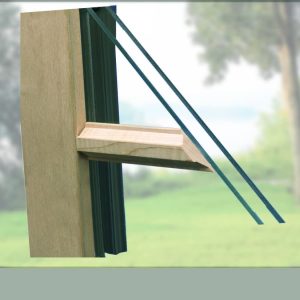 Interior Window Grilles. As their name implies, these window grilles are applied on the inside of the window glass. Practical in those instanced when you are more concerned with how the window looks on the inside of your home than on the outside. These window grilles are attached on the inside of your window and in some cases can be removed and reinstalled to make cleaning the inside of your windows easier.
Interior Window Grilles. As their name implies, these window grilles are applied on the inside of the window glass. Practical in those instanced when you are more concerned with how the window looks on the inside of your home than on the outside. These window grilles are attached on the inside of your window and in some cases can be removed and reinstalled to make cleaning the inside of your windows easier.
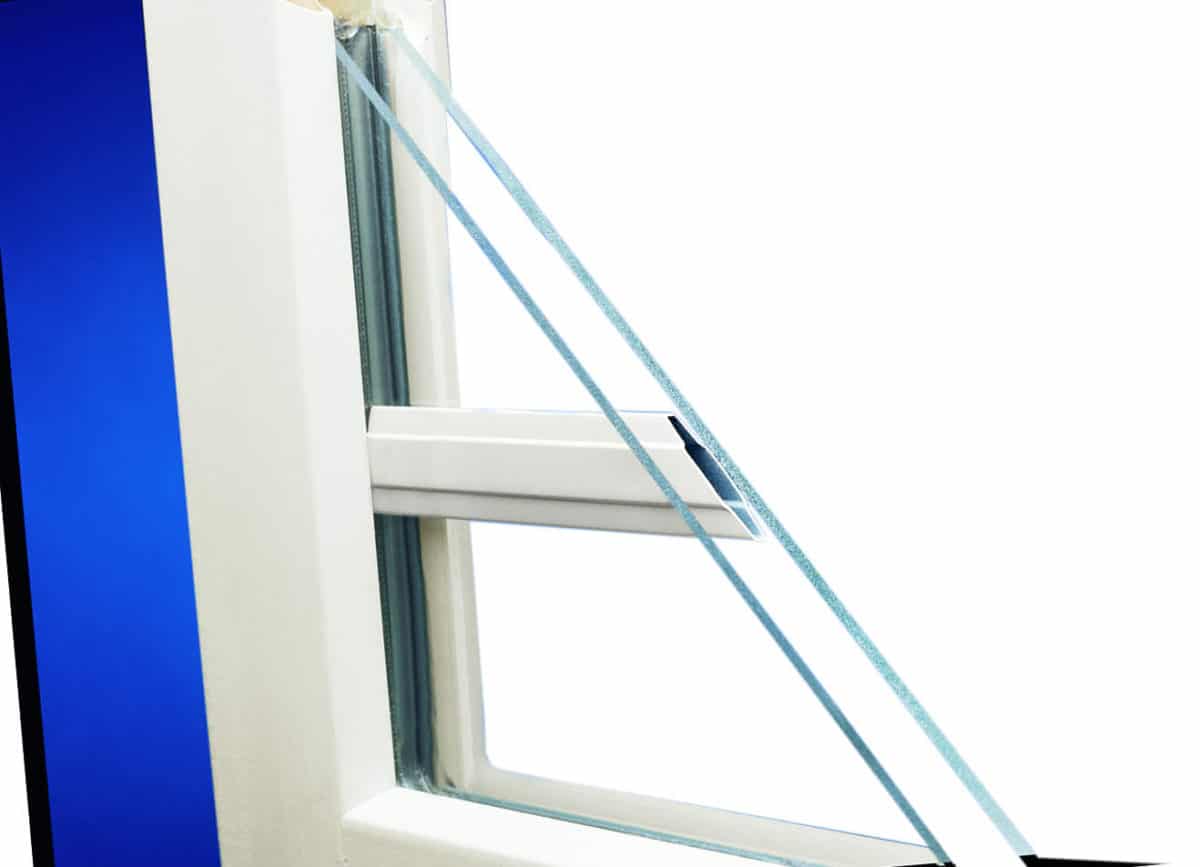 Between-the-Glass Window Grilles. If your primary consideration is ease of cleaning, these are the window grilles for you. Visibly the same from inside and out, these window grilles are permanently installed when the insulated glass units are manufactured. They sit between the two pieces of glass that make up your insulated glass unit, leaving a smooth surface inside and out.
Between-the-Glass Window Grilles. If your primary consideration is ease of cleaning, these are the window grilles for you. Visibly the same from inside and out, these window grilles are permanently installed when the insulated glass units are manufactured. They sit between the two pieces of glass that make up your insulated glass unit, leaving a smooth surface inside and out.
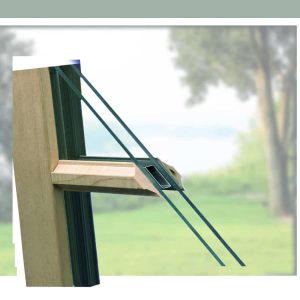 Full Divided Lite Window Grilles. If you took Interior-type window grilles and the Between-the-glass type and combined them, you would have these Full Divided Lite Window Grilles. Not to be confused with True Divided Lite Window Grilles, this type of Window Grill has a permanently applied low maintenance grille on the outside, a grille between the two sheets of glass that make up your insulated glass unit and a third grille on the inside, which can be either permanently applied or removable for cleaning. This option provides the truest visual replication of true divided glass.
Full Divided Lite Window Grilles. If you took Interior-type window grilles and the Between-the-glass type and combined them, you would have these Full Divided Lite Window Grilles. Not to be confused with True Divided Lite Window Grilles, this type of Window Grill has a permanently applied low maintenance grille on the outside, a grille between the two sheets of glass that make up your insulated glass unit and a third grille on the inside, which can be either permanently applied or removable for cleaning. This option provides the truest visual replication of true divided glass.
Window Grille Thickness. Be sure to pay attention to the thickness of the bars of your window grille, particularly if you have different window sizes on your home. A small window with very thick bars that make up the window grille will obstruct your view and look more out of place than no grille at all. By the same token, a very large window with very thin window grilles will look very odd indeed. Be sure you can get your window grilles in a size appropriate for your window size.
Window Grille Color. Are your window grilles available in a choice of colors to match your window frame or is your only choice white? While white might be the most common window grille color, that’s likely because white is the most traditional window frame color. Traditionally, true divided lite window frames were regularly painted the same color as the frame and you should match that look. If you’re not going to have white frames, why would you want white grilles? Beware of a window salesperson who tells you to paint your grilles to match the frames yourself. How likely are you to find a paint color that will exactly match your window frames? And what will you do when the paint starts to fade and the frame doesn’t (or vice versa). If you have a wood-framed window, can you get grilles to match?
In this final article in our long-running series on the Four Pillars of a Great Replacement Window Experience, we’ll discuss your choices of Window Insect Screens and important Window Maintenance features.
If you intend to open your windows (and who doesn’t?), keeping those annoying flying (and crawling) insects out of your home is an important consideration to you. Even if you have central air conditioning, there’s nothing better than opening the windows on one of those first warm spring days to let out the stale winter air and let in the fresh scent of spring.
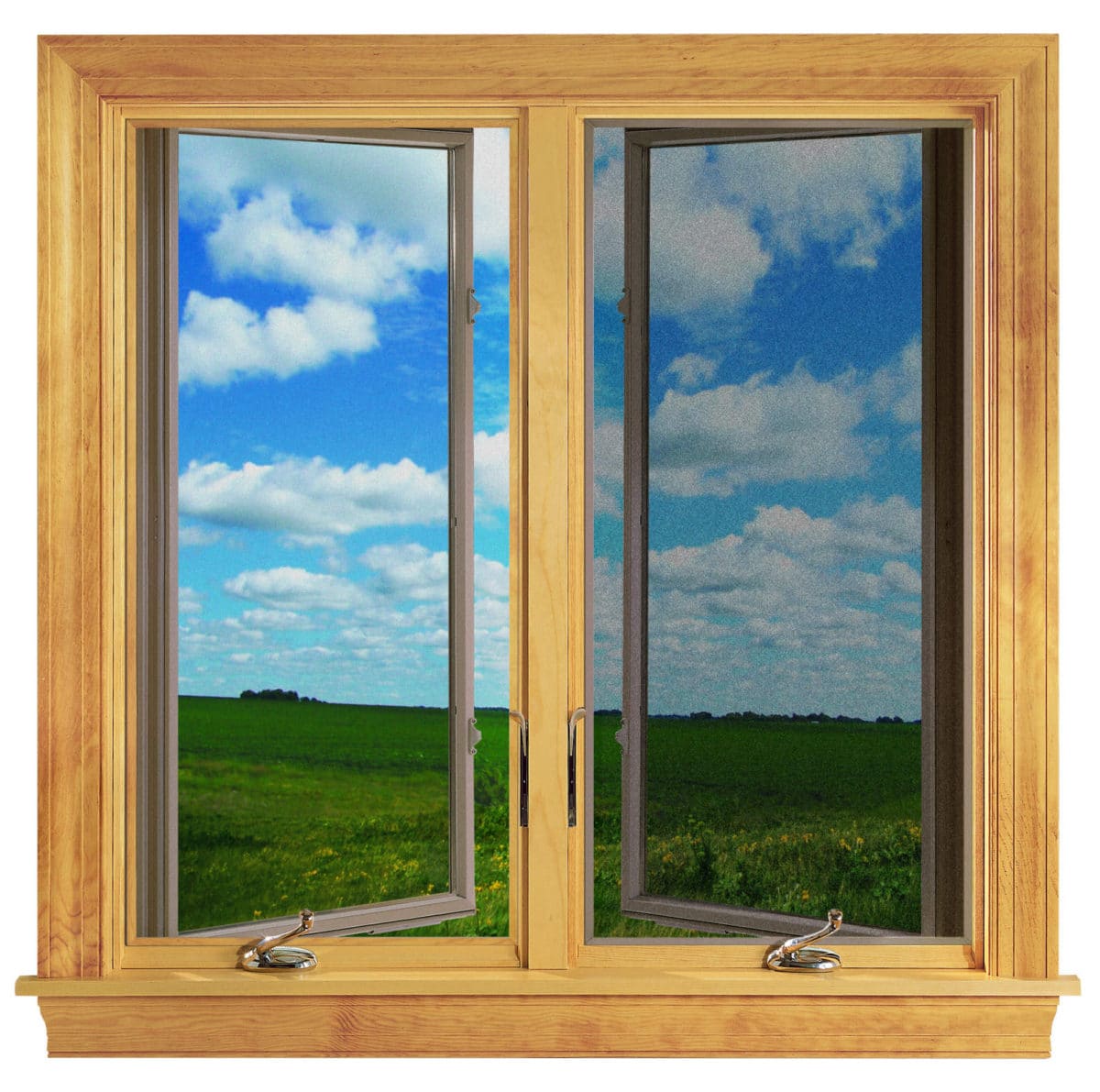 Often overlooked among all the other consideration of purchasing a replacement window, on Long Island, a good insect screen is an essential component of your window. You might be surprised to learn, however, that not all window screens are created equal.
Often overlooked among all the other consideration of purchasing a replacement window, on Long Island, a good insect screen is an essential component of your window. You might be surprised to learn, however, that not all window screens are created equal.
While most common window screens will help keep the bugs where they belong, some can really block your views and amount of natural light that comes through your windows. When considering your replacement window choices, be sure to look at the insect screens that will come with them and ask if they have different options. Consider what your views will look like through their standard insect screens and what they look like on the window itself. Is the insect screen so dark that it will block natural light or dramatically change your views outdoors? Does the frame of the screen blend into the window frame or stick out like a sore thumb?
Consider also how easy or difficult it will be to remove the window screens to clean them or your windows. Will you have to get on a ladder to remove the screens or can you remove them from inside? If you can’t see out your windows because of your insect screens or they make your home too darkm you’re ultimately not going to be happy with the windows themselves.
These days, some manufacturers offer a number of options in their window screens. Some of these new insect screens can deliver up to 50 percent more clarity than other window screens.
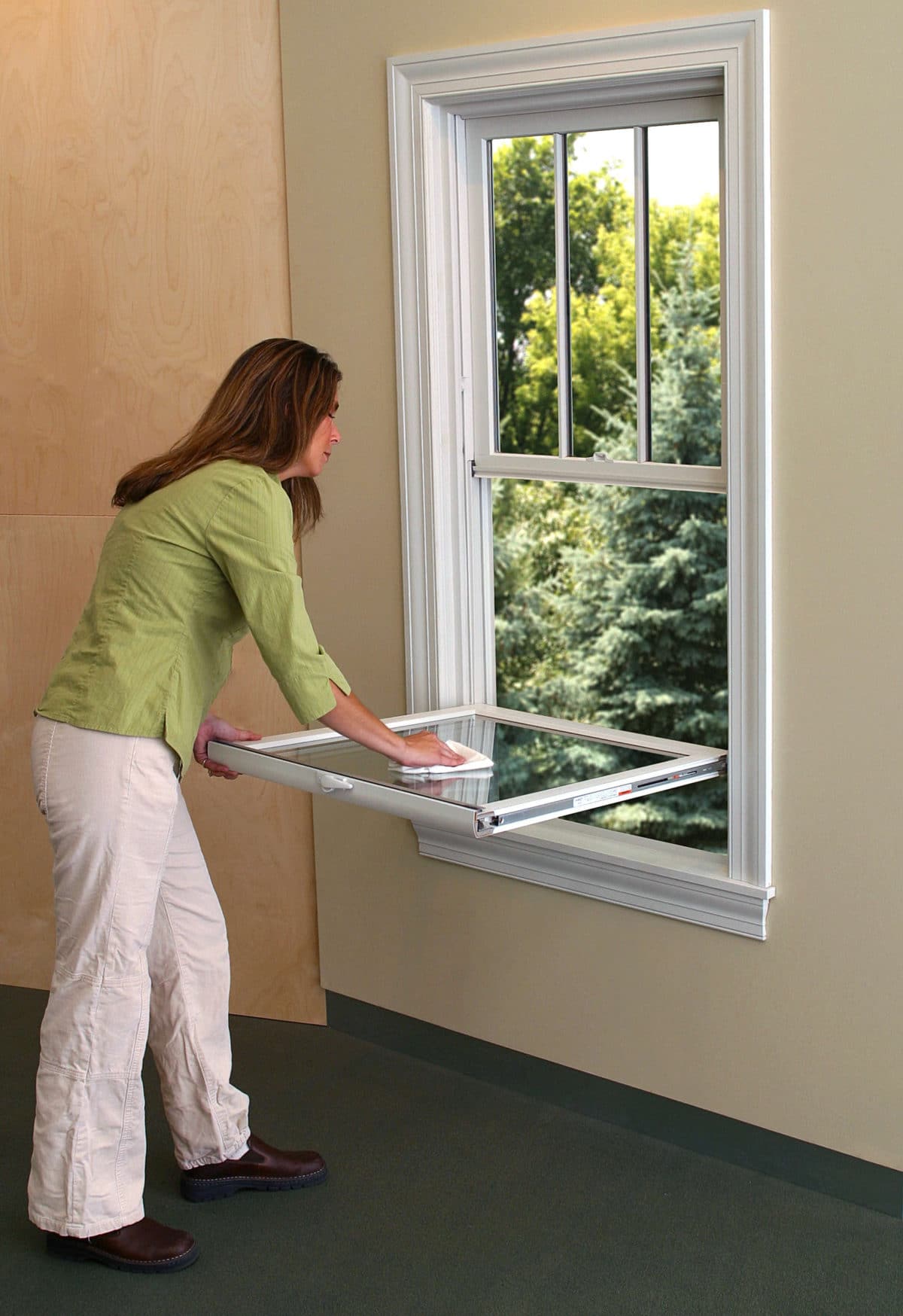 To maximize your views and your window’s operation over the lifetime of your windows they are going to need an occasional cleaning. We would all like to be able to say “I don’t do windows”, but someone’s got to do it. How simple or difficult that task will be depends is going to depend a great deal on how the window is designed.
To maximize your views and your window’s operation over the lifetime of your windows they are going to need an occasional cleaning. We would all like to be able to say “I don’t do windows”, but someone’s got to do it. How simple or difficult that task will be depends is going to depend a great deal on how the window is designed.
Consider the materials that make up your new replacement window. Some materials are considered low maintenance or claim to be maintenance free. Some will require more maintenance than others. Wood or metal windows will require an intensive regimen of regular maintenance while more modern materials will not. Do you want to scrape, sand and repaint your windows every couple of years?
Even newer windows will require some kind of cleaning. Be sure to inquire about how the manufacturer recommends cleaning the window frames and glass? Look at the window’s design. Are there many pockets, tracks and other areas that will be prone to collecting debris? These will have to be cleaned to keep your window operating at peak performance. Think about how will you clean these? Think about how you’re going to clean the outsides of the windows. Can you do it from inside the house? Will you have to get up on a ladder to clean the outsides of windows installed on the second story of your house?
 If the thought of cleaning your windows takes some of the fun out of shopping for new replacement windows, you’ll be happy to know that some glass options available from Renewal by Andersen of Long Island include a permanently applied factory glass coating on the outside of the glass to keep your class cleaner longer, requiring less frequent cleaning from you. Renewal by Andersen’s Low-E4 glass features a state-of-the-art titanium dioxide (TiO2) exterior coating which make your glass cleaning easier. When activated by sunlight, the coating helps loosen dirt on the glass, allowing it to be washed away by rain. And, the coating also helps the glass dry much faster so you have up to 99 percent fewer water spots on the glass.
If the thought of cleaning your windows takes some of the fun out of shopping for new replacement windows, you’ll be happy to know that some glass options available from Renewal by Andersen of Long Island include a permanently applied factory glass coating on the outside of the glass to keep your class cleaner longer, requiring less frequent cleaning from you. Renewal by Andersen’s Low-E4 glass features a state-of-the-art titanium dioxide (TiO2) exterior coating which make your glass cleaning easier. When activated by sunlight, the coating helps loosen dirt on the glass, allowing it to be washed away by rain. And, the coating also helps the glass dry much faster so you have up to 99 percent fewer water spots on the glass.
For more information on Renewal by Andersen of Long Island’s design features and options, contact us at (866) 609-5033 or fill out the short form on this page. We’ll be happy to answer any of your questions or set up an appointment to meet with you in person to show you.